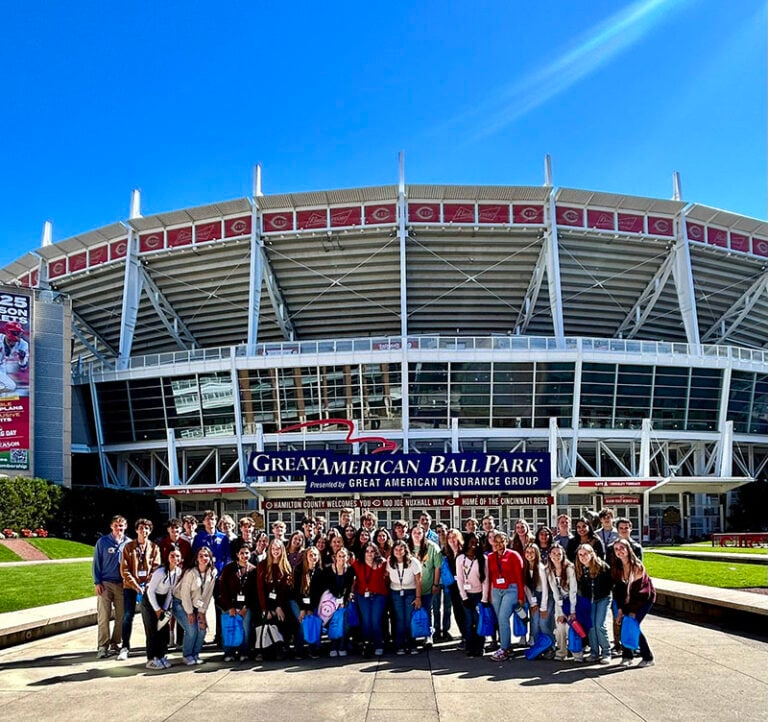By Howard Whiteman
Murray State University
They are seemingly everywhere these days. Driving on the highway, along the edges of woodlots, through residential communities, and everywhere from our small towns to the largest cities. The large, white blooms of the Bradford pear tree can brighten our day, reminding us that spring is coming.
Which would all be fine and good, except that Bradford pears are an invasive species, and they are everywhere for a reason: they spread like wildfire.
Invasive species are those that are not only introduced to a new area, but they spread quickly and cause harm to nature, humans, or our economy. Bradford pears are just like kudzu, Asian carp, and brown marmorated stinkbugs. The difference between them is that Bradford pears look pretty and most people don’t realize their dark side, which is perhaps indicated by the smell of those pretty blooms, just like rotting fish.

species in a nice suit. (Photo courtesy of Michael Rivera and Wikimedia under CC BY-SA 4.0)
You would think with a name like Bradford pear, it would have to be a native species. It is not. Also known as the Callery pear, it is native to China and Vietnam, but is commonly sold as an ornamental plant within the U.S. ‘Bradford’ is one cultivar of this tree, which was originally named after a French missionary who helped introduce it to Europe.
Ironically, Bradford pears were introduced in the U.S. by the United States Department of Agriculture (USDA) in Maryland in the 1960s. They were promoted by Lady Bird Johnson in 1966, the First Lady at the time, who planted one in Washington, D.C. Those facts are ironic because they are now listed on the USDA’s National Invasive Species Information Center website. Bradford pears have since established populations in 25 states. Given their negative effects, Ohio, Pennsylvania, and South Carolina have banned their sale and cultivation. Maybe we should too.
Bradford pears are invasive because they outcompete native trees and shade out native understory plants. Once planted — in your front lawn perhaps — they can spread to other properties, including our wetlands, grasslands, and forests. Birds inadvertently spread their seeds by eating their fruits, which means that they can spread quickly and over relatively long distances. They also have an economic effect because of their weak branches, which easily break during storms and often cause property damage.
Two basic approaches used by land managers to control Bradford pears and other
invasive trees are called “cut stump” and “hack and squirt”. In the cut stump method, you cut the tree down and then apply an herbicide to the top portion of the cut stump. Herbicides must be used because Bradford pears will resprout if you don’t. With hack and squirt, you use an ax to cut slits into a tree and then spray herbicide into the slits. You don’t have to be a professional to do either — anyone can do it! However, if you decide to use these methods, closely read the herbicide label to ensure you are correctly, safely, and legally applying them.
Now is your chance. Because they are in bloom or recently were, it is easy to identify Bradford pears on your property right now, whether that be your backyard or a forested property you own. Check out the flowers and leaves on the internet, make sure you have the right species, mark them with a ribbon, and then cut stump or hack and squirt them in the late summer or early fall when these methods are most effective. Next, think about an alternative, native tree that you could put in its place in your yard. Or sit back and watch native species take over the space of the Bradford pears that you removed. Both can be done with a sense of satisfaction, because for each Bradford pear you remove, somewhere a native tree species is benefitting, and they need all the help they can get.
You can also help by telling your neighbors about Bradford pears, nicely of course, and offering to help them and/or keeping them from buying and planting new ones.
Neighborly advice can go a long way, as can a community cut stump/hack and squirt
campaign.
Two opportunities to learn more are coming up this April. First, on Saturday, April 12, from 8:30 a.m.-1 p.m., there will be a Riverlands Alliance Invasive Species Team (RAIST) Field Day at the Golden Pond Visitor Center at Land Between the Lakes. We will learn more about invasive plant species affecting LBL from the Riverlands Alliance Coordinator, Dr. Andrea Darracq, and spend part of the day removing some of them, including Bradford pears. Bring your neighbors.
Second, on Saturday, April 26, from 10 a.m.-2 p.m. at Murray State’s Doran
Arboretum, we will be having an Earth Day event that will include a tree giveaway,
which is a perfect time to pick up a free tree to help you replace that pesky Bradford pear on your property. Plus, you can learn more about invasive plants at a table hosted by RAIST. If you don’t have time for either opportunity, or even if you do, you can visit the Riverlands Alliance website to learn more about invasive species in our region.
Trees are amazing organisms, but not all trees are the same. Bradford pears are an
invasive species that need to go and removing them is an easy way for you to make a
positive impact on our planet and country. So, learn how to cut stump or hack and squirt, and get out there and make a difference.
Dr. Howard Whiteman is the Commonwealth Endowed Chair of Environmental Studies and professor in the Department of Biological Sciences at Murray State University.





















